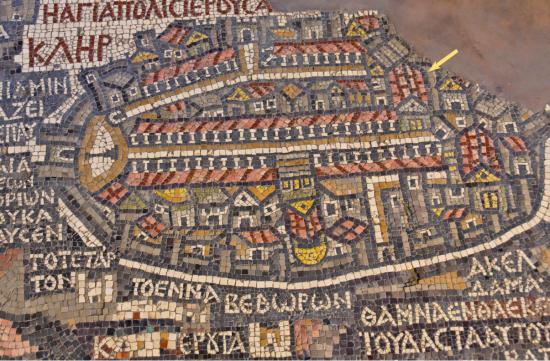Robin Ngo
Source - http://www.biblicalarchaeology.org/daily/biblical-sites-places/jerusalem/who-built-the-nea-church-and-the-cardo-in-jerusalem/

The sixth-century C.E. Madaba map shows the red-roofed Nea Church (indicated with an arrow) down the street from the Church of the Holy Sepulchre on the Jerusalem Cardo. Emperor Justinian I built the Nea Church—did he also build the Cardo in Jerusalem? Photo courtesy Todd Bolen/BiblePlaces.com.
On the sixth-century C.E. Madaba map, the Jerusalem Cardo, the city’s main street, can be seen running from the Damascus Gate through the middle of the city. The Church of the Holy Sepulchre lies along the Cardo at the center of the city. At the far end of the Cardo in Jerusalem sits a red-roofed church identified as the New Church of the Holy Mother of God and Ever-Virgin Mary, often simplified as the Nea Church. The Byzantine map depicts the Jerusalem Cardo as a Roman-style thoroughfare flanked by colonnades. Traditionally it was believed that the construction of the entire length of the Jerusalem Cardo was attributed to the Roman emperor Hadrian when he established Jerusalem as a Roman city called Aelia Capitolina after the Second Jewish Revolt in 135 C.E.
Excavations conducted in the southern part of the Cardo in Jerusalem in the 1970s, however, offered a new theory: The Byzantine emperor Justinian I may have taken part in constructing portions of the street. So who built the Jerusalem Cardo? The answer may lie with the magnificent Nea Church, as discussed by Oren Gutfeld in “The Emperor’s New Church on Main Street, Jerusalem” in the November/December 2013 issue of BAR.
Between 1970 and 1981, Nahman Avigad’s excavations on a 600-foot stretch of the southern part of the Jerusalem Cardo uncovered about 60 Byzantine architectural features, including bases, columns and capitals. While some of the column bases were found in situ, most of the architectural features were reused in later structures that lined the Cardo. Additionally, it was discovered that this southern portion of the Cardo was built directly on top of bedrock and showed no signs of earlier Roman construction. This evidence lends weight to the now-widely supported theory that the southern part of the Cardo in Jerusalem was constructed under Justinian.